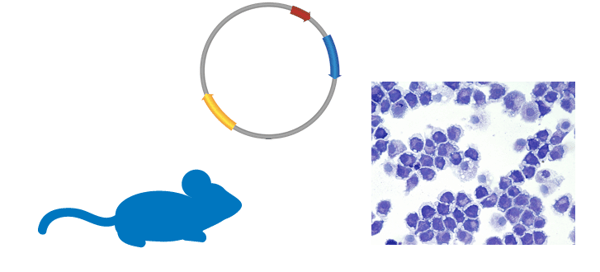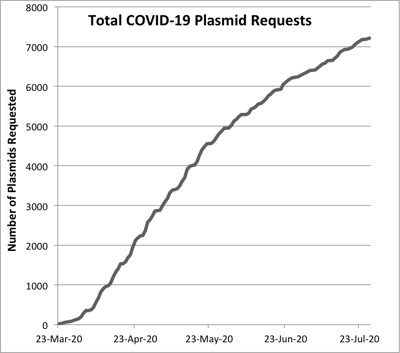Scientists need fast access to the tools required to study SARS-CoV-2, but with many academic research labs closed during the pandemic, it’s hard to get these reagents. However, when reagents have been made available through a repository, they remain accessible during these times. Centralized reagent repositories, also known as biobanks, are crucial for the advancement of SARS-CoV-2 research because they provide rapid access to validated reagents, especially during a time when these materials may not be available from their original sources.
 |
| Figure 1: Biological repositories that distribute mouse strains, plasmids, cell lines, and much more have been critical for pandemic research. Image from Reproducibility for Everyone. |
Case study 1: Cell lines
Many of the reagents used to investigate SARS-CoV-2 were developed for broad use and are now important for accelerating research into this virus. One such example is cell lines. The American Type Culture Collection (ATCC) is a private, nonprofit repository for a variety of materials for life science research, including over 4,000 cell lines. Seventeen of these cell lines were used to investigate the susceptibility of cells from different organisms to SARS-CoV-2 (Chu et al., 2020). An additional cell line used in this study came from the Japanese Collection of Research Bioresources Cell Bank, part of the National Institutes of Biomedical Innovation, Health, and Nutrition in Japan. These results will help researchers choose the best experimental model for further investigation of this pathogen. The sharing and distribution of cell lines from repositories on opposite sides of the world shows that science is truly a global endeavor.
Case study 2: Plasmids
Another example of reagents that have broad applications but have proven useful to the study of SARS-CoV-2 are the lentiviral production and packaging vectors VSV-G and psPAX2, which were used in a publication by Xiuyuan Ou, et al. that characterized the spike (S) protein of SARS-CoV-2 (Ou et al., 2020). The authors requested these plasmids from Addgene. This publication then resulted in the development of a new plasmid, pCMV14-3X-Flag-SARS-CoV-2 S, which is now easily available through Addgene and has already been requested dozens of times in 2 weeks. This is a striking example of the contributions that scientists are able to make when they have access to shared materials, and then pay it forward by making the new materials they develop available to the scientific community. Addgene was awarded a Fast Grant to ensure that the scientific community will continue having access to plasmids during the COVID-19 pandemic. Over 7,000 plasmids for COVID-19 research have already been requested from Addgene.
 |
| Figure 2: Total COVID-19 plasmids requested from Addgene from March 23, 2020 to July 27, 2020. |
Browse Addgene's COVID-19 plasmids and resources!
Case study 3: Mouse strains
Reagents developed during the SARS-CoV pandemic more than a decade ago are now being used to study SARS-CoV-2. The resurgence in popularity of the hACE2 transgenic mouse strain, for example, is sustained by the availability of this strain from The Jackson Laboratory. Originally developed and characterized by Stanley Perlman, of the Carver College of Medicine and Paul B. McCray, from the University of Iowa (McCray et al., 2006), the hACE2 transgenic mice were designed after it was discovered that SARS-CoV, which entered human cells via hACE2, could not enter cells expressing murine ACE2 (Subbarao et al., 2006). Now that a similar phenomena is appearing with regards to SARS-CoV-2, this mouse strain is regaining popularity. The Jackson Laboratory, a nonprofit research institution, has been able to rapidly propagate this strain, making it available to scientists around the world. This scale of production and distribution is possible due to the dedicated facilities and manpower that a repository provides.
Repositories around the world facilitate the rapid pace of SARS-CoV-2 research by removing logistic hurdles to continue making materials available rapidly to scientists (Nature Biotechnology 2020). The continued success of repositories, during the pandemic and in the future, depends on support from the scientific community. Deposits of new reagents, policies from journals and granting agencies requiring materials to be deposited into repositories, and financial support to maintain repositories’ capacity for storing, validating, and distributing such reagents are all ways in which the scientific community can support repositories. Repositories are essential for the advancement of scientific research, and mechanisms to maintain and grow these critical organizations should be a fundamental part of the scientific research infrastructure.
References
Chu H, Chan JF-W, Yuen TT-T, Shuai H, Yuan S, Wang Y, Hu B, Yip CC-Y, Tsang JO-L, Huang X, Chai Y, Yang D, Hou Y, Chik KK-H, Zhang X, Fung AY-F, Tsoi H-W, Cai J-P, Chan W-M, Ip JD, Chu AW-H, Zhou J, Lung DC, Kok K-H, To KK-W, Tsang OT-Y, Chan K-H, Yuen K-Y (2020) Comparative tropism, replication kinetics, and cell damage profiling of SARS-CoV-2 and SARS-CoV with implications for clinical manifestations, transmissibility, and laboratory studies of COVID-19: an observational study. The Lancet Microbe 1:e14–e23 . https://doi.org/10.1016/s2666-5247(20)30004-5
McCray PB Jr, Pewe L, Wohlford-Lenane C, Hickey M, Manzel L, Shi L, Netland J, Jia HP, Halabi C, Sigmund CD, Meyerholz DK, Kirby P, Look DC, Perlman S (2006) Lethal Infection of K18-hACE2 Mice Infected with Severe Acute Respiratory Syndrome Coronavirus. JVI 81:813–821 . https://doi.org/10.1128/jvi.02012-06
Ou X, Liu Y, Lei X, Li P, Mi D, Ren L, Guo L, Guo R, Chen T, Hu J, Xiang Z, Mu Z, Chen X, Chen J, Hu K, Jin Q, Wang J, Qian Z (2020) Characterization of spike glycoprotein of SARS-CoV-2 on virus entry and its immune cross-reactivity with SARS-CoV. Nat Commun 11: . https://doi.org/10.1038/s41467-020-15562-9
Subbarao K, Roberts A (2006) Is there an ideal animal model for SARS? Trends in Microbiology 14:299–303 . https://doi.org/10.1016/j.tim.2006.05.007
(2020) Open for outbreaks. Nat Biotechnol 38:377–377. https://doi.org/10.1038/s41587-020-0499-y
Additional resources on the Addgene blog
- Read more about COVID-19 databases and resources
- Learn about Addgene's work to share plasmids to all scientists
Resources on Addgene.org
- Find COVID-19 plasmids at Addgene
- Browse the entire plasmid collection
Topics: Scientific Sharing, Material Sharing, COVID-19






Leave a Comment